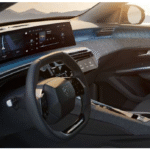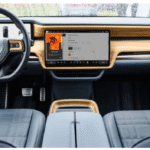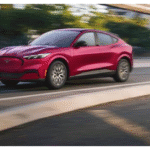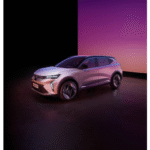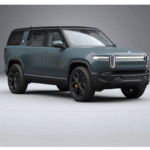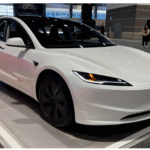Short answer? Electric cars are surprisingly great in cold weather—but with a few caveats. And the real-world experience is more impressive than most people think.
Let’s explore this through stories, science, specs, and what car companies are doing to make your winter drives smoother, warmer, and more efficient.
Electric Vehicle Performance in Cold Climates: The Basics
Electric cars, like all vehicles, react to extreme temperatures. But unlike internal combustion engine (ICE) vehicles, electric vehicles actually solve some winter headaches. Let’s unpack this.
Cold Weather Reduces Battery Range
Battery chemistry slows in cold weather. This leads to:
- Slower charging
- Less regenerative braking
- About 20–40% drop in range depending on conditions
But even here, the impact varies. A Massachusetts electric vehicle owner reports:
“I make a weekly 145-mile round trip and still return with 15% battery in winter, same as summer. My previous ICE car dropped MPG (miles per gallon) in winter. Electric vehicles just feel smoother and more reliable.”
No Engine = No Starting Problems
Electric vehicles don’t have spark plugs, starters, or fuel systems to freeze up. One user shared:
“Started my EV at -12°F (-24°C) without hesitation. Because it’s plugged in, I preheat the cabin. I come out to a warm car; ice melted. It’s lovely!” Massachusetts EV Owner
Compare that to scraping ice off a windshield in sub-zero temps.
Better Handling on Ice and Snow
Electric vehicles carry their heavy batteries low in the frame. That creates better balance and traction.
“With 4WD and snow tires, my EV climbs my icy driveway better than any car I’ve owned,”another electric vehicle owner reported.
“Even my mini old 2012 Nissan Leaf handles ice and snow like a champ. I can’t even spin it intentionally in icy parking lots,” said Canadian Leaf Owner.
Interior Comfort and Winter Convenience
Preheating while plugged in is one of the top EV winter perks.
“Set a timer for 7:30. At 8:00, car’s warm, windows are clear, doors open easily. I don’t miss de-icing or shoveling ice.” -Massachusetts EV owner
Most Canadian Leafs even come standard with heated seats and steering wheels—standard!
Regenerative Braking in Cold Weather
One issue that users point out is that regen braking becomes limited when the battery is cold.
“Cars need to adapt to limited regen braking. Otherwise, braking feels different in a way that can surprise you.” Quora
That said, companies like Tesla have pushed over-the-air updates to manage this, improving regen in winter and adjusting algorithms to maintain predictable braking.
What Do Electric Car Owners Say About Winter Driving?
Let’s highlight some real user experiences:
From Canada:
“Our Leaf still works at -40°C. No starting issues. Handles snow beautifully. Only downside: you lose ~40% range in extreme cold. But newer Leafs, Bolts, and Teslas fix that with bigger batteries.” Canadian Leaf Owner.
About Heat and Range:
“Some install biodiesel RV heaters to save battery on heating. But newer models have heat pumps that make this less of a concern.”
Electric Vehicle vs AWD (All-Wheel Drive) ICE (Internal Combustion Engine) Car:
“My wife drove her dad’s AWD Chevy Equinox after snowfall. She came back and said: ‘Our EV is so much easier to drive in snow.’”
Electric Car Manufacturer Innovations to Improve Cold Weather Driving
Electric vehicle companies are fully aware of winter concerns. And they’ve taken major steps to resolve them.
Tesla: Heat Pumps and Smarter Software
- Heat pump in Model Y and newer vehicles improves cabin and battery heat without heavy power use.
- Octovalve system distributes thermal energy more efficiently. Tesla’s Octovalve is a smart cooling and heating system that helps the car use less energy and stay at the right temperature. It keeps the battery, motor, and cabin comfortable in all weather, saving power and boosting range.
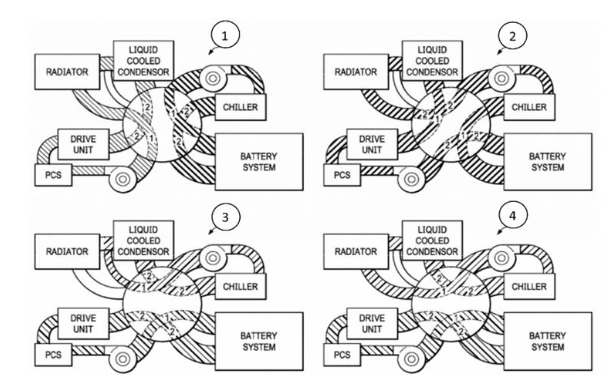
OCTOVALVE STATES FROM THE TESLA PATENT
Source: https://scispace.com/pdf/octovalve-thermal-management-control-for-electric-vehicle-1eugk07p.pdf
- Software updates adjust regenerative braking to work better in cold climates.
Hyundai IONIQ 5: Snow Mode and Battery Conditioning
- Snow Mode improves traction and braking control.
- Heat pump preserves range in winter.
- Battery preconditioning warms the battery before charging for faster performance.
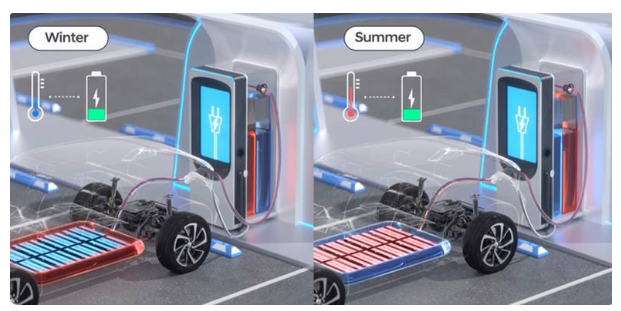
CHARGING OPTIMIZATION TECHNOLOGY USING EXTERNAL THERMAL MANAGEMENT STATIONS
Source: https://www.hyundaimotorgroup.com/story/CONT0000000000135654
Audi e-tron: Advanced Heat Recovery
- Heat pump uses waste heat from the motor.
- Maintains up to 80% of range at 0°C (32°F).
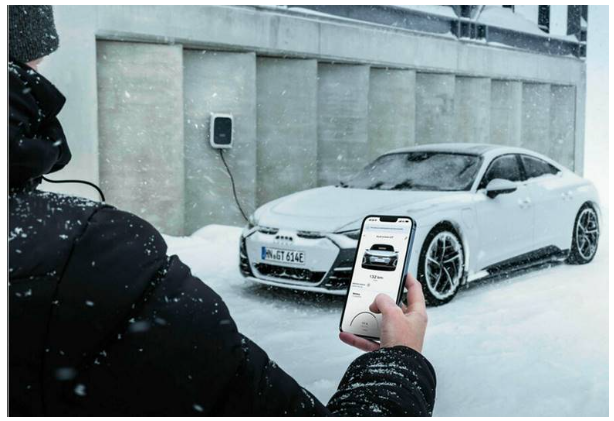
AUDI E-TRON WINTER TECH
Source: https://www.audi-mediacenter.com/en/press-releases/electromobility-in-winter-intelligent-thermal-management-in-audi-models-preserves-range-and-performance-14442
Nissan and Chevy: Bigger Batteries and Canadian Testing
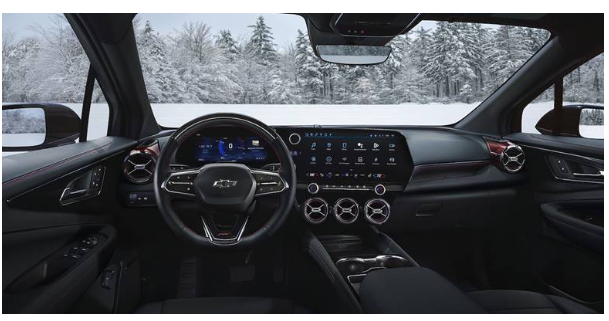
CABIN HEATING IN CHEVY
Source: https://www.chevrolet.com/electric/ev-range-battery/cold-weather
- New Leafs and Bolts come with improved insulation, larger batteries, and onboard thermal systems to prevent cold-weather underperformance.
Electric vehicles are being designed with cold in mind—not just adapted. It’s no longer “electric vehicles struggle in the cold,” it’s “Some electric vehicles used to—but not anymore.”
Which Electric Cars Handle Cold the Best?
Here’s a quick look at how popular electric cars compare for winter:
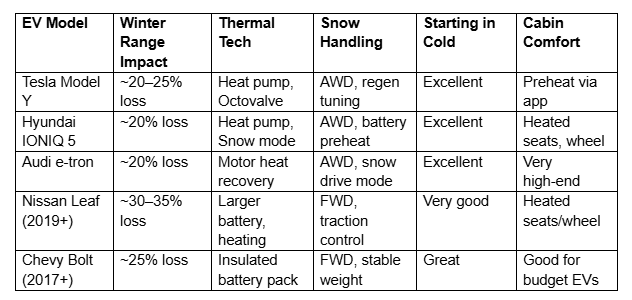
EVs vs Gas Cars in Winter: Psychological and Practical Edge
Gas cars suffer too—just differently:
- Lower MPG in cold
- Vapor lock
- Dead batteries
- Icy windshields
- Warming up engines takes forever
Electric vehicles:
- Start instantly
- Preheat without idling
- Stay warm on schedule
- Lower center of gravity for better grip
Electric vehicles feel more controlled in winter. It’s not just mechanical—it’s psychological.
“I used to stress every winter morning. Now, my car is ready when I am. No scraping, no starting issues, no worries.”
Final Verdict: Do Electric Cars Run Better in Cold Weather?
Yes—with the right electric vehicle, the right tires, and smart charging habits, electric cars are easier, smoother, and more comfortable in winter than gas cars.
Thanks to user-friendly upgrades and smart manufacturer engineering, electric vehicles today are more than capable in freezing climates.
